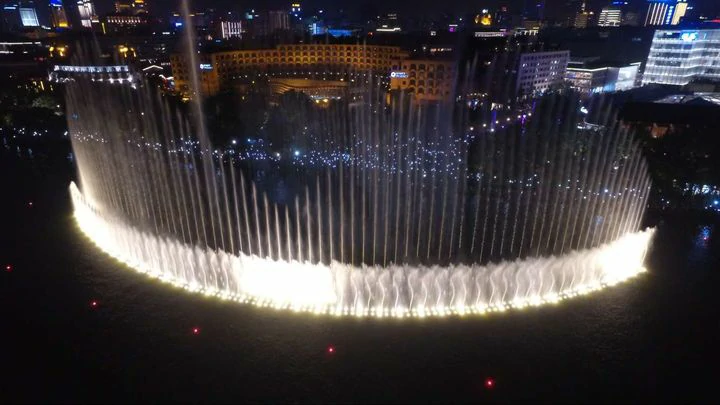Discussing Safety Measures for Fountain Water Features
Fountain water features, by utilizing water, electricity, light, and music, create dynamic and beautiful scenes, adding enjoyment and delight to people’s lives. Belonging to the realm of human-centered environmental spaces, fountain design incorporates various elements such as water circulation systems, lighting systems, sound systems, laser systems, electrical wiring, and cabinets (electrical boxes). The elements posing safety risks are diverse, including electricity, water, light, fire, sound, and sharp architectural elements, making accidents a possibility due to the complexity of these systems.
In recent years, safety incidents involving fountain water features have occurred sporadically. However, with proper safety precautions in place, including meticulous design, stringent control over equipment quality, conscientious adherence to construction procedures, and scientifically sound operational management, accidents can be prevented. To address safety concerns and prevent casualties in fountain water feature projects, this article attempts to discuss safety measures from four perspectives: safety design, equipment control, electrical safety, and operational management.
Fountain water features primarily consist of water systems, lighting systems, sound systems, laser systems, electrical wiring, and cabinets (electrical boxes). The wide range of elements posing safety risks includes electricity, water, light, fire, sound, and sharp architectural elements, all of which could lead to accidents. The implementation of fountain water features involves design, construction, and post-operation management steps. Design, being the initial step, is crucial for implementing safety precautions. Safety consciousness should be established from the outset of design, considering various safety factors comprehensively and ensuring thorough and adequate design.
Presently, fountain water feature safety incidents mainly stem from electrical equipment leakage in water pools, leading to electrocution when people come into contact with or enter the water for recreation. To prevent such incidents, several factors must be considered during design: prevention of electrical equipment leakage, selection of safe voltage equipment, installation of leakage protection for electrical equipment, and establishment of safety precaution signs.
Based on the function of the fountain pool, it can be categorized into play pools, fountain pools, and dry fountains. Fountain pools can be divided into three zones (designated as A, B, and C). Zone A refers to the pool area and the airspace 2.5 meters above it; Zone B encompasses the area within 2 meters from the pool edge vertically, extending up to 2.5 meters above the ground or reachable level; Zone C covers the parallel vertical area 1.5 meters outside Zone B, extending up to 2.5 meters above the ground or reachable level. Safety design for fountain pools should be based on practical considerations, selecting appropriate voltage levels and equipment. Safety standards for fountain pool design prioritize personal safety, irrespective of the chosen voltage level.
Safety measures for fountain pool design should include:
Reasonable Design of Zone A:
Zone A is the core area of the fountain pool, where equipment is concentrated and people frequent. It is the area most susceptible to electric shock, thus requiring stringent safety measures.
Equipment within Zone A should have a protection rating of no less than IPX8 to prevent water leakage and subsequent electric shock.
Cables connecting equipment and lights in Zone A should be double-insulated BVV wires or waterproof cables.
Distribution boxes connecting to underwater lights and equipment in Zone A should be positioned away from the pool edge to avoid human contact.
Junction boxes are not permitted in Zone A to minimize the risk of electrical faults.
Electrical equipment voltage in Zone A should be carefully selected, with LED light sources recommended, operating at 12V for Class III fixtures. Power switches for LED lights should not be located in Zone A. Low-power submersible pumps can use 12V power supplies, with transformers placed outside Zone A. High-power submersible pumps can operate at 380V but must meet a protection rating of no less than IPX8, with power supplied through isolation transformers and control switches equipped with leakage protection.
Reasonable Design of Zone B:
Although Zone B is not directly on the water’s surface but adjacent to it, it still encounters water and sees considerable foot traffic, making it the second most important safety area after Zone A.
Equipment within Zone B should have a protection rating of no less than IPX5, capable of withstanding water jets from various directions. Generally, Zone B does not accommodate live equipment for safety reasons.
Similar to Zone A, junction boxes are prohibited in Zone B.
To prevent electrical cable leakage currents from flowing to Zone A, cables in Zone B should be insulated and buried at a depth of no less than 0.8 meters.
Reasonable Design of Zone C:
Zone C, situated 3.5 meters away from the pool, experiences frequent human traffic and potential water splashes, serving as the third safety area to prevent electric shock incidents.
Equipment within Zone C should have a protection rating of no less than IPX4, capable of mitigating the harmful effects of splashing water from different directions. The threat of electric shock in this area is lower compared to Zones A and B.
Ideally, 220/380V equipment should be kept away from Zone C; however, if this is not feasible, as long as the protection rating requirements are met, isolation transformers and power switches can be installed in Zone C.

